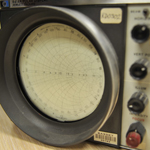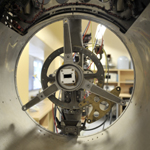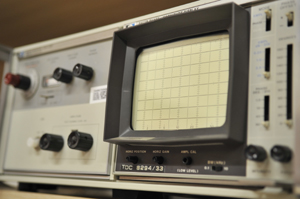Radar comes of age at UCT
30 March 2009 |
| Still going strong: Prof Mike Inggs has seen many innovations over his 21 years with the group; (below) the team circa 2006. |
UCT's Radar Remote Sensing Research Group has come of age.
When people think about radar, most imagine the round green screen of wartime submarines.
A few hours spent with Professor Mike Inggs in the Faculty of Engineering & the Built Environment changes that.
Inggs has headed the radar research group since its birth 21 years ago, in 1988.
"Radar is the champagne of electronics," explains Inggs. "It has every aspect of engineering: mechanics, physics, and the environment. You have to be a generalist if you are interested in radar technology."
Radar, an acronym for 'radio detection and ranging', can detect the presence of stationary or moving objects at a distance, and can determine their speed. But it's the third use - radar used as a mapping tool - that preoccupies Inggs and his team.
One of the research group's first big projects was funded by Armscor.
"It was an exciting time," says Inggs. "It was 1989, and the development of computer technology was making the analysis of the radar data much more comprehensive."
The group built some of the first processing hardware, and until the project was moved to the Council for Scientific and Industrial Research, it analysed synthetic aperture radar (SAR), recorded by a specially-equipped aircraft as it flew over the area to be mapped.
 |
 |
"Our original funders were looking at military applications," he says. "Metallic objects reflect differently and are easy to see; for example, if military units are moving around."
But it was the peacetime applications that really interested the team.
"Radar penetrates through clouds, through vegetation and even the upper level of the soil," explains Inggs. "That makes it an ideal tool for disaster management. It's also ideal for early prediction of crop yields. It really should be used more, because we could save millions by recognising when yields are going to be poor, and buying ahead early.
"Radar is also one of the most important weather prediction tools. Using scatterometers, we can measure the strength and direction of surface winds and the height of ocean waves."
Sadly, lack of funding has put paid to much of the unit's SAR work.
"I was excited by the possibilities of low-frequency, long-wavelength radar," says Inggs, "but in the late 90s the defence budget was reduced, so we only managed to have the equipment fitted onto one Dakota. The data it produced was really useful, but by 2005, following brief use of the technology for a De Beers geological survey, the SAR work was effectively over."
Inggs has hopes of a revival now that South Africa is establishing its own space agency, but in the interim the team has explored many other applications.
"In the mid-90s we began to use sub-surface radar. The penetration depth varies according to the soil composition, from a few metres in some types of rock to kilometres in ice. It's very useful for landmine detection, but the First World seems to have lost interest in that, so it's not used as much as it could be."
 |
UCT received funding from US company Bell Aerospace to build very sophisticated ground-penetrating radars that are particularly useful in civil engineering. The radar units are fitted to borehole drills, giving prospectors an idea of what is happening outside the core.
Instruments are being developed by a private company in the US.
"Most of our funding comes from overseas. We can offer a lot more research and analysis for the dollar," says Inggs.
What of the future? A new radar laboratory was opened at UCT on March 24, providing welcome relief for a department that has doubled in size in the past 13 years.
Inggs is also excited about many new applications. Since 2005, he has worked on Passive Coherent Location (PCL) technology.
"The Earth is full of signals, from things like TV and radio. We're building systems that will allow us to parasite off this energy to implement radar detection of aircraft. It's perfect for the Third World. We'll be able to use it, for example, to build air-traffic control systems at a fraction of their present cost."
Inggs believes that 'cognition', the ability to adapt to the surrounding environment, should be built into this type of radar. One of the pioneers of cognitive radar, Professor Simon Haykin of McMaster University in Canada, is extremely interested in the group's work, and will visit UCT early next year.
Inggs and his team are also working with University College, London, on network radar, in which clusters of radar units collaborate. The UCT team is responsible for the software and very precise clocks that are used to synchronise the units.
 This work is licensed under a Creative Commons Attribution-NoDerivatives 4.0 International License.
This work is licensed under a Creative Commons Attribution-NoDerivatives 4.0 International License.
Please view the republishing articles page for more information.










